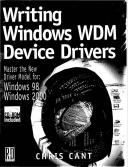Книга: Writing Windows WDM Device Drivers
Testing Wdm2
Testing Wdm2
The Wdm2Test Win32 console application in the Wdm2exe subdirectory of the book software tests the Wdm2 driver. Wdm1Test is the same as Wdm1Test with only one change, apart from referencing the Wdm2 driver. Wdm2Test halts halfway through, waiting for the user to press a key. While it is waiting, it has a handle to the first Wdm2 device still open.
First, install a Wdm2 device using one of the installation INF files in the book software Wdm2sys directory. It does not matter whether you use the free or checked build, although the checked build produces DebugPrint trace output.
Wdm2Test tests to see if a Query Remove request is rejected while there are any open handles to a Wdm2 device. Run Wdm2Test but do not press a key when it stops halfway through. Now try to remove the Wdm2 device or reinstall its driver. The request should be rejected. Windows will state that the system must be restarted for the operation to complete.
Check that the Wdm2 driver can be removed or reinstalled when Wdm2Test has completed.
It is very difficult to test the other new aspects of Plug and Play support in the Wdm2 driver. First, Stop Device and Surprise Removal requests should never be issued for virtual devices that have no resources. Second, it is not possible to suddenly remove a Wdm2 device in such a way that the Wdm2 driver has to wait for pending I/O to complete. Do appropriate tests for drivers that have resources and can be suddenly removed.
If the test for open handles is not made, then W2000 in fact will still not allow the device to be removed, as it must contain its own internal reference count for the device. However, W98 would let the device be removed. Any I/O requests on open handles would then simply fail.
Actual Plug and Play Messages
The DebugPrint output from Wdm2 shows exactly which Plug and Plug messages are sent by Windows during add device and remove device operations.
Adding a Device
The following PnP calls are made when a Wdm2 device is successfully added, or when the driver for a device is reinstalled. Two of the messages are issued only by Windows 2000.
AddDevice
(W2000) IRP_MN_QUERY_LEGACY_BUS_INFORMATION
IRP_MN_FILTER_RESOURCE_REQUIREMENTS
IRP_MN_START_DEVICE
IRP_MN_QUERY_CAPABILITIES
IRP_MN_QUERY_PNP_DEVICE_STATE
IRP_MN_QUERY_DEVICE_RELATIONS BusRelations
IRP_MN_QUERY_DEVICE_RELATIONS BusRelations (W2000)
Removing a Device
The following PnP messages are sent when a Wdm2 device is successfully removed, or when the driver for a device is reinstalled.
IRP_MN_QUERY_DEVICE_RELATIONS RemoveRelations
IRP_MN_QUERY_REMOVE_DEVICE
IRP_MN_REMOVE_DEVICE
Unknown Status Returns
It is interesting to note the IRP status values are returned by the lower Unknown driver when Wdm2 sends IRPs down the stack. Windows is supposed to set the IRP status return value to STATUS_NOT_SUPPORTED before it is issued to the top of the device stack. If Wdm2 sees this value on return from its PnpDefaultHandler routine, it means that the lower drivers have not processed the IRP or have deliberately not returned STATUS_NOT_SUPPORTED.
For Wdm2, W98 succeeds all the PnP IRPs that it receives.
For Wdm2, W2000 does not process IRP_MN_FILTER_RESOURCE_REQUIREMENTS, IRP_MN_QUERY_PNP_DEVICE_STATE, IRP_MN_QUERY_BUS_INFORMATION, and IRP_MN_QUERY_DEVICE_RELATIONS IRPs.




